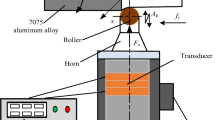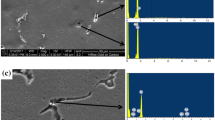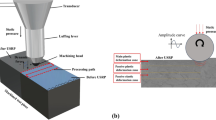Abstract
Two-dimensional ultrasonic surface rolling process (TDUSR) is an effective method to improve fatigue, wear, and corrosion resistance of materials by producing strain hardening and changing stress state and microstructure. In this paper, the experiment and finite element simulation of two-dimensional ultrasonic surface rolling 7075 aluminum alloy were carried out to study the evolution of the microstructure and the relationship between the surface grain size and micro-hardness. Deform was redeveloped on the basis of grain refinement model to simulate the change of grain size of 7075 aluminum alloy after TDUSR treatment. The micro-hardness and grain size obtained by TDUSR were analyzed using micro-hardness tester and XRD diffractometer. The relationship between the grain size and micro-hardness was established based on the experimental results. The simulation and experimental results showed that the grain size in the rolled region decreased greatly after TDUSR treatment. And the grain size refined from micron to nanometer, forming a gradient nanocrystalline structure along the radial direction. The grain refinement might be caused by the comprehensive influence of the surface equivalent stress and the equivalent strain rate when the static load was less than 150 N. When the static load exceeded 150 N, the plastic deformation temperature also had a certain effect on the grain refinement. TDUSR treatment can promote the preferred grain orientation and change the microstructure in the rolled surface layer. The inverse Hall-Petch phenomenon existed in the nanostructured surface layer, and the surface micro-hardness increased with the increment of the grain size.












Similar content being viewed by others
References
Dobosy A, Gáspár M, Török I (2018) Resistance spot welding of 7075 aluminum alloy[J]. Vehicle and Automotive Engineering 2:679–693
Fernando C, Ruano OA (2018) Superplasticity of aerospace 7075 aluminum alloy obtained by severe plastic deformation[J]. Defect and Diffusion Forum 385:39–44
Pandey V, Chattopadhyay K, Santhi Srinivas NC, Singh V (2017) Effect of stress relieving treatment on low cycle fatigue behavior of USSP treated 7075 aluminum alloy[J]. Materials Science and Engineering 194:012037
Delgado P, Cuesta II, Alegre JM, Díaz A (2016) State of the art of deep rolling[J]. Precision Engineering 46:1–10
Xu X, Liu D, Zhang X, Liu C, Liu D, Zhang W (2019) Influence of ultrasonic rolling on surface integrity and corrosion fatigue behavior of 7B50-T7751 aluminum alloy[J]. International Journal of Fatigue 125:237–248
Lu L, Sun J, Li L, Xiong Q (2016) Study on surface characteristics of 7050-T7451 aluminum alloy by ultrasonic surface rolling process[J]. The International Journal of Advanced Manufacturing Technology 87(9-12):2533–2539
Li G, Qu S, Pan Y, Li X (2016) Effects of the different frequencies and loads of ultrasonic surface rolling on surface mechanical properties and fretting wear resistance of HIP Ti–6Al–4 V alloy[J]. Applied Surface Science 389(15):324–334
Rajabi F, Zarei-Hanzaki A, Eskandari M, Khoddam S (2013) The effects of rolling parameters on the mechanical behavior of 6061 aluminum alloy[J]. Materials Science & Engineering A 578(31):90–95
Muñoz-Cubillos J, Coronado JJ, Rodríguez SA (2017) Deep rolling effect on fatigue behavior of austenitic stainless steels[J]. International Journal of Fatigue 95:120–131
Ramos R, Ferreira N, Ferreira JAM, Capela C, Batista AC (2016) Improvement in fatigue life of Al 7475-T7351 alloy specimens by applying ultrasonic and micro-shot peening[J]. International Journal of Fatigue 92(1):87–95
Cheng M, Zhang D, Chen H, Wei Q, Li J (2016) Surface nano-crystallization and its effect on fatigue performance of high-strength materials treated by ultrasonic rolling process[J]. The International Journal of Advanced Manufacturing Technology 83(1-4):123–131
She D, Yue W, Du Y, Fu Z, Wang C, Liu J (2015) Vacuum tribological properties of titanium with a nano-crystalline surface layer[J]. Tribology Letters 57:1
Ben Moussa N, Gharbi K, Chaieb I, Ben FN (2019) Improvement of AISI 304 austenitic stainless steel low-cycle fatigue life by initial and intermittent deep rolling[J]. The International Journal of Advanced Manufacturing Technology 101:435–449
Zhang Q, Hu Z, Su W, Zhou H, Liu C, Yang Y, Qi X (2017) Microstructure and surface properties of 17-4PH stainless steel by ultrasonic surface rolling technology[J]. Surface and Coatings Technology 321:64–73
Zhao W, Liu D, Zhang X, Zhou Y, Zhang R, Zhang H, Ye C (2018) Improving the fretting and corrosion fatigue performance of 300M ultra-high strength steel using the ultrasonic surface rolling process[J]. International Journal of Fatigue 121:30–38
Yin M, Cai Z, Zhang Z, Yue W (2019) Effect of ultrasonic surface rolling process on impact-sliding wear behavior of the 690 alloy[J]. Tribology International.
Gavrilova TM (2008) Contact friction in the deformation zone during ultrasonic surface plastic deformation[J]. Russian Engineering Research 28(8):764–768
Estrin Y, Mecking H (1984) A unified phenomenological description of work hardening and creep based on one-parameter models[J]. Acta Metallurgica 32(1):57–70
Chul Baik S, Estrin Y, Seop Kim H, Jörg HR (2003) Dislocation density-based modeling of deformation behavior of aluminium under equal channel angular pressing[J]. Materials Science & Engineering A 351(1-2):86–97
Wu Y, Li S, Hou B, Yu Z (2013) Dynamic flow stress characteristics and constitutive model of aluminum 7075-T651[J]. The Chinese Journal of Nonferrous Metals[J] 3:658–665
Wang Z, Xiao Z, Huang C, Wen L, Zhang W (2017) Influence of ultrasonic surface rolling on microstructure and wear behavior of selective laser melted Ti-6Al-4V Alloy[J]. Materials 10(10):1203
Pande CS, Cooper KP (2009) Nano-mechanics of Hall–Petch relationship in nanocrystalline materials[J]. Progress in Materials Science 54(6):689–706
Sato YS, Urata M, Kokawa H, Ikeda K (2003) Hall–Petch relationship in friction stir welds of equal channel angular-pressed aluminum alloys[J]. Materials Science & Engineering 354(1-2):298–305
Funding
This work was supported by the National Natural Science Foundation of China (grant numbers 51005071, 51575163) and the Key Scientific Research Project for the Universities in Henan Province, China (grant number 16A460006).
Author information
Authors and Affiliations
Corresponding author
Additional information
Publisher’s note
Springer Nature remains neutral with regard to jurisdictional claims in published maps and institutional affiliations.
Rights and permissions
About this article
Cite this article
Zheng, J., Liu, H., Ren, Y. et al. Effect of two-dimensional ultrasonic rolling on grain size and micro-hardness of 7075 aluminum alloy. Int J Adv Manuf Technol 106, 503–510 (2020). https://doi.org/10.1007/s00170-019-04640-y
Received:
Accepted:
Published:
Issue Date:
DOI: https://doi.org/10.1007/s00170-019-04640-y




